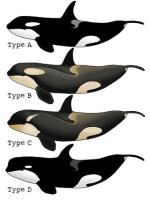 The title of the paper published in the journal Polar Biology doesn’t help much, unless you are biologist. The paper is titled, “Mitogenomic insights into a recently described and rarely observed killer whale morphotype.” Lara Sorokanich writing in National Geographic translates the news into layman’s English. Her article is titled, “Rare Breed of Killer Whale May Be New Species.” Scientists studying the skeleton of a rare type “D” orca now believe that the unusual type of orca may be its own species or at least a sub-species. As reported in National Geographic:
The title of the paper published in the journal Polar Biology doesn’t help much, unless you are biologist. The paper is titled, “Mitogenomic insights into a recently described and rarely observed killer whale morphotype.” Lara Sorokanich writing in National Geographic translates the news into layman’s English. Her article is titled, “Rare Breed of Killer Whale May Be New Species.” Scientists studying the skeleton of a rare type “D” orca now believe that the unusual type of orca may be its own species or at least a sub-species. As reported in National Geographic:
Scientists used a portion of the whale’s skeleton to map type D’s genome. They then compared their results with the genomes of the more common orcas—types A, B, and C—to determine the genetic differences among all four varieties.
The study revealed that type D’s genetic differences date back nearly 400,000 years. These ancient variations may qualify type D as an entirely new species or subspecies of killer whale, though further evidence will be needed before the proposal is confirmed.

But they are still not whales, they belong to the Dolphin family.
I think biology was the only class I passed with an grade A in high school.
Whale is kind of a loose term, but I think they were using whales to mean “cetaceans” here, Phil. In other words, as they were using it, all dolphins are whales/cetaceans, but not all whales/cetaceans are dolphins. The problem is that there is that whales in everyday English really just means cetaceans that are too big to be dolphins. That’s why terms like toothed whales (Odontocetes) and baleen whales (Mysticetes) are more useful.
I will have to go read this article. It seems eminently plausible to me. My work in grad school was similar in that I looked at mitochondrial DNA and found that mice that were generally considered subspecies were probably separate species based on the amount of divergence in their genomes.
Not to argue, but I’ve hear it in the past, and here is more.
Orcas (Killer Whales), Orcinus orca ~ MarineBio.org
And they are the largest of the dolphin family (Family Delphinidae ~ 32 species, including what we normally consider dolphins, pygmy killer whales, Feresa … http://marinebio.org/species.asp?id=84
Killer Whales (Orcas) – National Geographic, Orcas, or killer whales, are the largest of the dolphins and one of the world’s most powerful predators. They feast on marine mammals such as seals, sea lions, … http://animals.nationalgeographic.com/animals/mammals/killer-whale/
False Killer Whale : Dolphins : Voices in the Sea, Stats: Max Weight: 3,000 lbs (1,360 kg); Length: Female 16.5 ft (5 m) Male 19.5 ft (6 m); Diet: Squid and a wide variety of fish including mahi mahi and tuna … http://cetus.ucsd.edu/voicesinthesea_org/species/dolphins/falseKiller.html